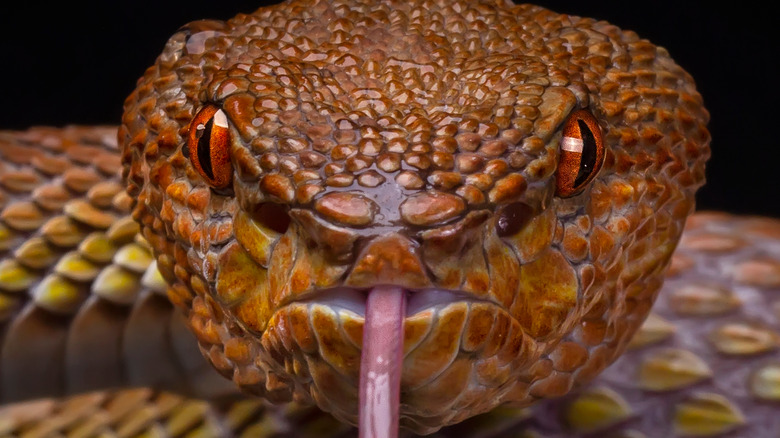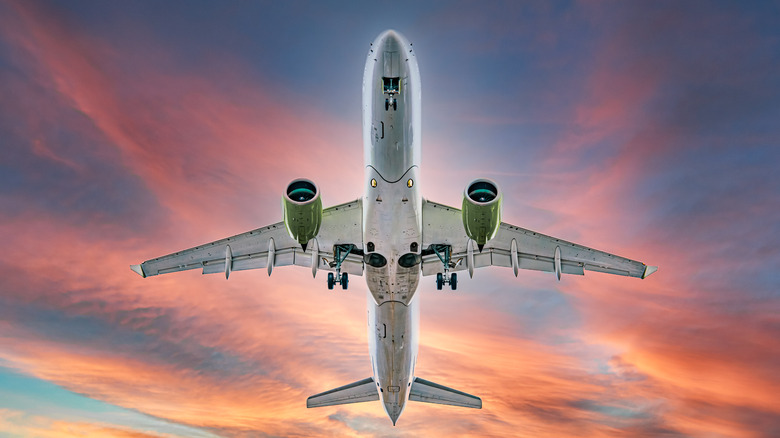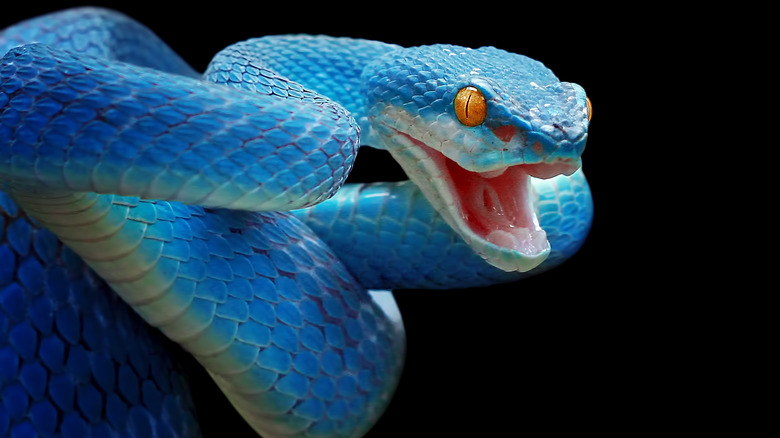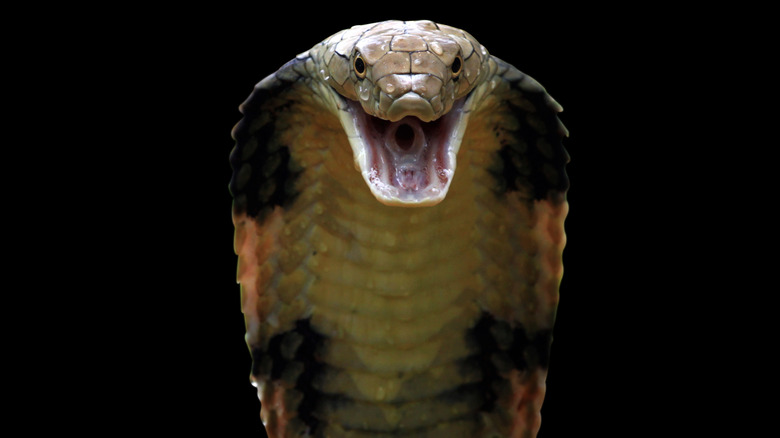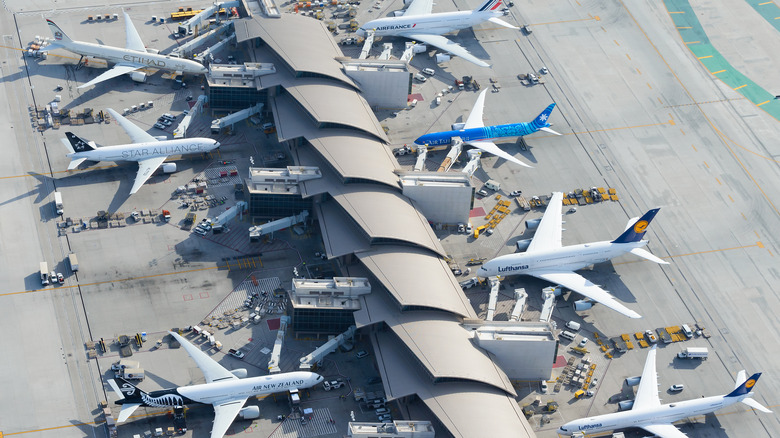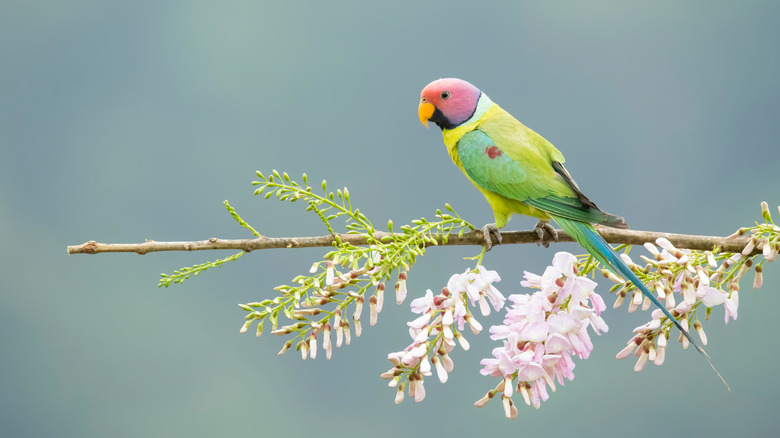The Surprising Reality Of Snakes On Planes
When Samuel L. Jackson burst onto the screen in the 2006 blockbuster hit "Snakes on a Plane," proclaiming there were — you guessed it — a slew of venomous snakes soaring through the skies on a plane full of human passengers, the idea seemed a bit far-fetched, even for cinema. The surprising reality is that snakes winding up on planes is a relatively common phenomenon, not just a handful of isolated incidents.
As it turns out, these sneaky, slithering reptiles are so crafty at clambering into aircraft cargo that clearing planes of snakes is now a multi-million-dollar business, complete with its own line of real-life snake detectives. The Atlantic reports that these snake sleuths are a hidden aspect of aircraft travel that rarely get attention unless, of course, they fail, and snakes really wind up on a passenger plane. In a captivating interview, invasive species scientist Robert Reed stated, "there are literally hundreds of examples of snakes being transported by aircraft."
Snakes can survive the high altitudes and frigid temperatures of flight
The sunny skies don't seem like the perfect atmosphere for a snake, but no worries. These cold-blooded creatures can adjust. They're just as crafty in an aircraft as they are in your backyard, according to experts. The Atlantic reports that snakes have carved out a multitude of ways to clamber unnoticed onto commercial flights. Some of their favorite entrances include the wheel basins and cargo areas, precisely where your precious luggage might be stored. According to Travel and Leisure, it can get pretty cold in the cargo area of some flights, but for most snakes this, too, is fine.
Snakes appear to pull off Herculean feats when they hop on commercial airplanes. Some examples include enduring tumultuous winds as fast as 300 mph and tolerating sub-freezing temperatures as low as 10 degrees Fahrenheit. In one notorious incident, a 12-foot python dangled from the wing of a commercial airliner and survived a 500-mile journey while suspended 30,000 feet in the air (via Daily Mail).
In February of 2022, a domestic flight was interrupted due to a snake invasion
Passengers aboard a commercial Malaysian airline headed from capital city Kuala Lumpur to the metropolis of Tawau were rerouted when crew members spotted a peculiar-looking reptilian stowaway (via USA Today). The snake slithering through the overhead lights of the aircraft was not identified by species, but it immediately became an internet sensation. It all began when a passenger spotted a sinister silhouette slithering to and fro overhead and did what anyone would do in such a position: They reached for the smartphone and began recording.
The snake on that plane immediately went from slippery jetsetter to TikTok star in a video that garnered millions of views (per TikTok). As the narrow serpent made its way through the airplane's interior, the pilot swiftly changed direction, landing the plane in the neighboring city of Kuching. The plane was fumigated before passengers were permitted to return and resume their flight to the original destination of Tawau.
According to The Atlantic, species scientist Robert Reed believes the smartphone is the only reason regular passengers are waking up to the reality that snakes can and often do board planes. In a candid interview, he spoke of a separate incident in which a snake was videotaped dangling from a plane's exterior wing, saying, "The reason this snake is getting so much attention is that people saw it happening and everyone's cell phones shoot movies now."
Smuggling snakes onto planes is a somewhat common practice
A 2012 incident sparked hysteria when a reptile shop owner smuggled his Egyptian cobra onto a flight headed to Kuwait from Cairo (per CNN). This instance was one where the sneakiness was not coming from the snake but from the store owner. When the venomous cobra was out of the bag, 90 passengers were struck with terror. One was even bitten.
In an ironic twist, the cobra sunk its teeth into the very shop owner who smuggled it on board in the first place. The man was identified as 48-year-old Akram Abdul Latif, who despite being delivered a potentially deadly bite, refused medical treatment or even surveillance (via Reptiles Magazine). To put things into perspective, according to National Geographic, a cobra's venom is so poisonous that one bite is enough to kill approximately 20 people or, alternatively, one elephant.
And if you think one cobra on a plane is deadly, brace yourself, because a Texas man managed to smuggle seven deadly serpents on a flight from South America to the United States (per CBS News). With such sophisticated airplane tech at airports these days, you're probably assuming this guy is some kind of smuggling mastermind with advanced tactics to evade airport security, but no. The eccentric eco-tourism enthusiast merely stuffed the slippery guys inside his jacket, successfully completing several flights before being caught.
Airplane graveyards are basically snake havens in the desert
When the world stopped as a result of the COVID-19 pandemic, there were endless unexpected consequences. According to CBS News, one of the most unexpected consequences was rattlesnakes infesting thousands of parked planes. You read that correctly. With travel at a screeching halt for the majority of 2020, airplanes had to be parked and stored by the thousands, an occurrence that has since been dubbed "airplane graveyards." This phrase is particularly deceptive when you consider the fact that these parked planes are anything but dead. Indeed, they are bursting with life in the form of deadly Mojave rattlesnakes and predatory scorpions.
Now mechanics are tasked with ridding parked aircraft of the "feisty rattlers" sliding around the wheels and brakes and hiding inside the cracks and crevices. According to Statista, global tourism is a $4.7 trillion business, so you might expect these mechanics to have some pretty sophisticated rattlesnake battling equipment. Of course, you would be wrong. The airlines have armed them with only repurposed broom handles which they lovingly refer to as "wheel whackers," for obvious reasons.
The prospect of snakes on planes is pretty dangerous for birds
From a human perspective, the most threatening element of snakes on a plane is that of a venomous bite taking place while en route to the family vacation spot. There have certainly been incidents of venomous bites (per CNN) and other oddities, such as snakes finding their way into the shoes of unsuspecting passengers and traveling thousands of miles (via CNN). With engineers brandishing nothing more than repurposed broom handles and hundreds of incidents taking place, this thought could certainly put a damper on the family getaway. However, The Atlantic reports that if the snake safely survives a mile-high journey and winds up in a far-flung region of the world, the consequences could be dire — for birds.
One example of this has already taken place. When the brown tree snake hitched a flight to Guam and succeeded to cross the wind and sky, it was to the detriment of the birds native to that region. Now, the USDA Wildlife service fears similar fates in other regions of the world if we don't get these snakes on planes under control.
